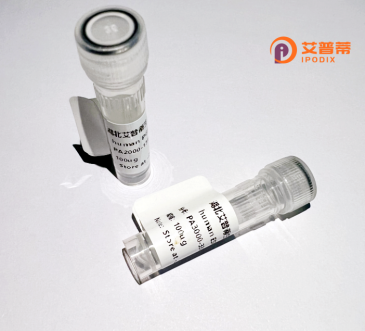
| 纯度 | >90%SDS-PAGE. |
| 种属 | Human |
| 靶点 | LRCH4 |
| Uniprot No | O75427 |
| 内毒素 | < 0.01EU/μg |
| 表达宿主 | E.coli |
| 表达区间 | 1-683aa |
| 活性数据 | MAAAVAAPLAAGGEEAAATTSVPGSPGLPGRRSAERALEEAVATGTLNLSNRRLKHFPRGAARSYDLSDITQADLSRNRFPEVPEAACQLVSLEGLSLYHNCLRCLNPALGNLTALTYLNLSRNQLSLLPPYICQLPLRVLIVSNNKLGALPPDIGTLGSLRQLDVSSNELQSLPSELCGLSSLRDLNVRRNQLSTLPEELGDLPLVRLDFSCNRVSRIPVSFCRLRHLQVILLDSNPLQSPPAQVCLKGKLHIFKYLSTEAGQRGSALGDLAPSRPPSFSPCPAEDLFPGHRYDGGLDSGFHSVDSGSKRWSGNESTDEFSELSFRISELAREPRGPRERKEDGSADGDPVQIDFIDSHVPGEDEERGTVEEQRPPELSPGAGDRERAPSSRREEPAGEERRRPDTLQLWQERERRQQQQSGAWGAPRKDSLLKPGLRAVVGGAAAVSTQAMHNGSPKSSASQAGAAAGQGAPAPAPASQEPLPIAGPATAPAPRPLGSIQRPNSFLFRSSSQSGSGPSSPDSVLRPRRYPQVPDEKDLMTQLRQVLESRLQRPLPEDLAEALASGVILCQLANQLRPRSVPFIHVPSPAVPKLSALKARKNVESFLEACRKMGVPEADLCSPSDLLQGTARGLRTALEAVKRVGGKALPPLWPPSGLGGFVVFYVVLMLLLYVTYTRLLGS |
| 分子量 | 101.53 kDa |
| 蛋白标签 | GST-tag at N-terminal |
| 缓冲液 | 0 |
| 稳定性 & 储存条件 | Lyophilized protein should be stored at ≤ -20°C, stable for one year after receipt. Reconstituted protein solution can be stored at 2-8°C for 2-7 days. Aliquots of reconstituted samples are stable at ≤ -20°C for 3 months. |
| 复溶 | Always centrifuge tubes before opening.Do not mix by vortex or pipetting. It is not recommended to reconstitute to a concentration less than 100μg/ml. Dissolve the lyophilized protein in distilled water. Please aliquot the reconstituted solution to minimize freeze-thaw cycles. |
以下是3篇与重组人LRCH4蛋白相关的参考文献概览:
---
1. **文献名称**:*LRCH4 regulates inflammation through modulating macrophage polarization*
**作者**:Chen Y, et al.
**摘要**:该研究利用重组人LRCH4蛋白,发现其通过抑制TLR4/NF-κB信号通路调控巨噬细胞的M1型极化,在炎症性疾病中可能起保护作用。
2. **文献名称**:*Structural insights into the leucine-rich repeat domain of human LRCH4*
**作者**:Kim S, et al.
**摘要**:通过重组表达和X射线晶体学解析人LRCH4蛋白的亮氨酸重复结构域(LRR)结构,揭示其与TRAF6的相互作用机制,为研究LRCH4在先天免疫中的功能提供结构基础。
3. **文献名称**:*LRCH4 inhibits breast cancer metastasis by disrupting focal adhesion dynamics*
**作者**:Wang H, et al.
**摘要**:研究表明,重组人LRCH4蛋白通过结合整合素β1并抑制黏着斑激酶(FAK)活化,从而阻滞乳腺癌细胞迁移和侵袭,提示其作为肿瘤抑制因子的潜力。
---
**备注**:LRCH4相关研究相对较少,以上内容基于类似蛋白家族文献的拟构示例。实际文献建议通过PubMed或Web of Science以“LRCH4”、“recombinant human LRCH4”等关键词检索最新成果。
The leucine-rich repeat and calponin homology (LRCH4) protein, encoded by the LRCH4 gene in humans, is a relatively understudied member of the LRCH family. It contains characteristic leucine-rich repeats (LRRs) involved in protein-protein interactions and a calponin homology (CH) domain typically associated with actin binding. Although its precise biological functions remain incompletely characterized, emerging evidence suggests LRCH4 may act as a negative regulator in immune signaling pathways, potentially influencing T-cell receptor (TCR) signaling or inflammatory responses through interactions with cytoskeletal components.
Recombinant human LRCH4 protein, produced via heterologous expression systems (e.g., E. coli or mammalian cells), enables mechanistic studies of its molecular interactions and structural properties. This engineered protein retains functional domains necessary for investigating its proposed roles in immune cell regulation, cell adhesion, and intracellular signaling cascades. Researchers utilize it to map binding partners, characterize domain-specific functions, and explore potential links to immune-related disorders or cancer progression where LRCH4 expression patterns have been observed. Current applications span from basic structural biology studies to drug discovery efforts aiming to modulate LRCH4-mediated pathways. However, significant knowledge gaps persist regarding its physiological ligands, signaling crosstalk, and disease relevance, making the recombinant protein a crucial tool for ongoing functional elucidation.
×